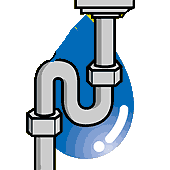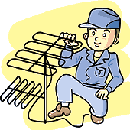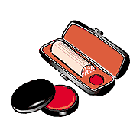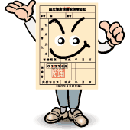

J&Fハウス、J&Fマンスリーは、ガスコンロなどガス器具が備えられています。また、ガス代を含め光熱費はすべて家賃に含まれています。ですから、ガスの開始や支払いの手続きは不要です。
この地域で使われているガスは、大きく分けて都市ガスとLP(プロパン)ガスの2種類があります。都市ガスは地域によりガスの種類が異なっています。
There are two common types of gas used in Japan. City gas, and
liquefied petroleum gas (LP; i.e., propane gas). The type your apartment uses
will depend on the area you live in.
ガスの種類によって使用する器具が異なります。適合していない器具を使うと火災などの危険がありますので、使用前には、必ず家主などにガスの種類を確認してください。
Appliances may operate differently depending on the type of gas
you fuel them with. Fires or other accidents may result if you use the wrong
type of gas with the wrong type of appliance. Before using any gas-powered
appliance or machine, be sure to check with your landlord as to what type of gas
your building is supplied with.
ガスが漏れていたら、まず、屋内の火を全部消し、ガス機器の使用を中止し、部屋やメーターのガス栓を閉めて下さい。(LPガスはガスボンベの元栓・器具栓を閉めて下さい。)そして、窓を開けて風通しを良くし、ガスを追い出します。また、至急、販売業者(*)に連絡し、点検が終わるまでガスを使わないようにして下さい。
*ガス会社(都市ガスの場合)か販売業者(LPガスの場合*)に連絡して下さい。(ガス警報機やガスボンベに連絡先がかかれている場合もあります)
If you suspect a gas leak, extinguish all indoor fires, stop
using all gas-powered appliances, and turn off the gas valves in each room. (If
LP gas is used, turn off the valves of gas cylinders・appliances) Then open all
your windows to ventilate the room. Immediately contact your gas provider*, and
do not use the gas again until they have checked your building
thuroughly.
* If you use Toshi gas (city/town gas), contact the gas company. If you use LP gas, contact the cylinder dealer. The contact number will most likely be written on the cylinder, or the gas alarm.
漏れたガスに火花が引火しないように、次の3点を必ず守ってください。
1.ガス漏れ警報器をコンセントから絶対抜かない
2.電気器具のスイッチやコンセントの差込に触れない
3.換気扇は絶対に回さない。
To prevent fire in the event of a gas leak, please observe the
following rules:
1.Do not pull the plug of the gas alarm.
2.Do not touch any outlets, or the switches of any electrical appliances
3.Do not turn off the ventilation fan.
LPガスは、空気より重いので、低いところに溜まります。そのため、低い位置にいる乳幼児やペットは大変、危険ですのでご注意ください。
LP gas is heavier than air and gathers close to the ground. In
the event of a leak, take extra precautions to protect small children and pets,
who are most likely to be down there.
この地域のガスは、(** )ガス会社が供給しています。
Natural gas is supplied by a certian gas company throughout any
given city.
転出の2、3日前までに、近くの(** )営業所に、検針票に記載されているお客様番号、現在の住所、氏名、転出後の連絡先、使用開始日を連絡してください。約束の日時に係員が訪問し、ガスメーターを確認し、料金を精算します。
Call the office of the company serving your city a few days
before you move out, and tell them your customer number as indicated on your gas
bill/receipt, as well as you present address, name, new address, and the day you
will resume use of their services. A service person will visit your residence on
the appointed day, check the meter, and calculate your bill.
(2)LPガス−プロパンガス(LP gas-プロウペインPropane ギャスgas)
プロパンガスを新たに使用されるときは、安全確認をするために、使用前の検査が必要です。必ず、家主に点検が済んでいるかどうか確認してください。点検していない場合は、ガスボンベ・ガスメータ−などに納入業者の名前と電話番号が記入されていますので、業者に連絡を取り、必ず検査を受けてから使って下さい。
Before you can use LP gas(propane gas), a safety inspection is
required. Ask the landlord whether your building has already been inspected. If
not, be sure to contact your local LP provider. (The provider's name and phone
number should be written on the gas cylinder・gas meter.)
引っ越しその他でLPガスの使用を中止するときは、早めに納入業者に日時をご連絡下さい。当日、業者が安全を確認し、中止の手続きを行います。
When you no longer need LP gas (because you are moving or for any
other reasons), contact your provider with the time and date you will
discontinue use. The dealer will then come to prepare the LP gas for
discontinuance.
ガス料金は、基本料金と使用料料金の合計額が毎月、請求されます。基本料金は、ガスの種類等に応じて決まっています。使用量料金は、係員が毎月使用料メーターを検針して計算します。
The price of gas is sometimes determined by the amount of gas
you use. Sometimes there is a fixed rate. If your gas company charges by the
amount of gas you use, they will inspect the meter every month to determine your
bill.
支払方法は、金融機関や郵便局からの口座振替と、ガス会社から郵送される振込用紙で、振り込む方法があります。(ガス会社、金融機関、郵便局、コンビニエンスストアなどで支払えます)
You can pay your bill by automatic transfer through your bank or
postal account. The alternative is to pay cash at a (ガス会社名 ) Gas service office,
bank, post office, or convenience store.

上水道は、(** )水道局が供給しています。
The (** )Waterworks Bureau supplies tap water throughout the city.
水道の使用を申し込むときは、お住まいの市区町村の水道営業所に連絡してください。その際、名前、住所、使用開始日などを知らせてください。(**営業所TEL )
When you move into your new accommodations, contact the nearest
service office of the Waterworks Bureau and inform them of your name, address
and the date you will need service from. (**Waterworks Bureau Service Office TEL
NO. )
水道料金は、下水道使用料と合わせて2ヶ月ごとに請求します。水道メーターの検針は、4ヶ月ごとに行います。検針のとき「上下水道料金のお知らせ」をお渡しします。
Water charges for households include a water and a sewage fee.
Bills are sent to all households every other month.
Water meter readers come to read the meter every four months, leaving slips informing the residents of the volume of water used each term.
支払方法は、金融機関の口座から自動的に振り替える「口座振替制」と金融機関、水道局の窓口、コンビニエンスストアなどから現金で支払う「納付制」があります。
You can pay the bill through the automatic payment system from
your bank or postal account, or you can pay directly at a post office,
convenience store, or Waterworks Bureau service office.
転居などで使用を中止する時は、事前にお住まいの水道営業所に連絡してください。
If you are moving out and wish to discontinue your water, notify
the nearest Waterworks Bureau service office in advance.

(1)使用開始(スタートゥStart オブof ユーズuse)
電気は、(** )電力が供給しています。周波数は( )ヘルツ、電圧は100ボルトです。
(** )Electric Power Co., Inc. supplies power throughout the area. The
frequency is ( )Hz, and the voltage is 100V.
転居して電気の使用を開始するときは、ブレーカーのツマミを「入」にしてください。(まれに電力会社が工事しなければ使用できない場合もあります)
When you move in to your new residence and begin to use
electricity, flip the breaker switch up. (During construction, you may not be able to use electricity inyour building)
ブレーカーは、容量を超える電流が流れた時に自動的に電気を遮断する装置です。(普通、玄関の上や浴室まわりにあります。)
A breaker is designed to shut off the supply of electricity
automatically when the flow of current exceeds the system's capacity. (Usually,
a breaker is located above a front door or around a bathroom.)
点灯を確認したらブレーカーに取り付けてあるか、郵便受けに投函してある「ご使用開始連絡用ハガキ」に必要事項を記入し、郵送してください。
After confirming that electricity is working, fill in the
pertinent information on the postcard that should be attached to the breaker or
inserted in your mailbox.
もし、ハガキが見つからない場合や電気がつかないときは、(*電話番号 )(** )営業所まで電話してください
If you cannot find the postcard, or the electricity is not working,
call the(** )Center at TEL(* )(in Japanese).
電気料金は、実際に使用した電力量(電力会社がメーターを検針します)をもとに計算されます。支払い方法は、金融機関や郵便局からの口座振替と郵送された振込用紙で振
り込む方法があります。振込は、金融機関のほか、(** )電力会社窓口やコンビニエンスストアでも可能です。
Your electricity bill is determined by monthly meter readings
(checked by The electric co. personnel every month). You can pay your bill by
automatic transfer from your bank or postal account, or directly at a financial
institution, (** ) branch office, or convenience store.
住戸で使える最大アンペアは、住宅により異なっています。アンペアを変更したい場合は、受け持ちの営業所に相談の上、(**
)電力に依頼してください。その際、必ず事前に家主、又は不動産業者にご連絡下さい。
The maximum amperage that can be used in your unit varies
depending on the housing complex. If you want to change the amperage, consult
your local office, and then apply to (** ) Electric Power Company. Be sure to
tell the landlord or agent about it in advance.
(4)引越しが決まったら(ムーヴィンMoving アウトout)
引越しするときは、引越しの日が決まったらすぐ(** )センターに、住所、氏名、引越し日時、引越し先、お客様番号(「電気ご使用料のお知らせ」などに記入)を連絡して下さい。
As soon as you have determined the day of your move, call the (** )Center and tell them your name, address, the day you will move out, your new address, and your customer number (indicated on your electric bill/power consumption notice.)
引越しの当日に係員が使用量のメーターを調べにきますので料金を精算してください。
On the day you move, your meters will be checked, and you will
be asked to pay for all electricity used up until that point.

(1)電話(Phones)
各J&Fハウスには、公衆電話が設置されています。しかし、海外へは、かけられなかったり音が聞こえなかったりすることがあります。海外へ電話をかける場合には、駅周辺にある国際電話用の公衆電話を利用するか個人の携帯電話をお使いください。
Each J&F guest house has a public phone, but many of these phones cannot be used for international calls. Even if you can reach overseas, the reception may not be very good. If you need to call overseas, we reccomend you use a public phone at train station, or use a private cell phone.
直通で国際電話をかけるには、国際アクセス番号 + 国番号 + 地域番号 +
電話番号の順にかけます。国際アクセス番号というのは、国際電話をかけるときに国番号の前にダイヤルする番号です。日本から外国にかける場合の国際アクセス番号は、001(KDDI)か041(日本テレコム)を使います。外国から日本にかける場合は、その国の国際アクセス番号をダイヤルします。
To make an international call, dial as follows. (International
access code)+(Country code)+(Area code)+(Phone number)
The
international
access code is is dialed first, to establish that you are about to make an international call. From Japan, it is 001 or 0041. The code varies depending on the country you are calling from.
はじめて口座を開くときは、まず、「普通預金申込書」に次の必要事項を記載します。・氏名、住所、入金額(必ずいくらか入金することが必要)
When opening an account you must first of all fill out the
"Application for Saving Account."form with the following information:
Name, address, and the amount you will be depositing that day.
手続きは「ご新規」の窓口で行います。
The counter labeled "ご新規go-shinki(New Accounts)" is the one where you can open a new account.
氏名欄の右端の丸欄には、印鑑を押印します。印鑑を持っていない場合は、サインでも受け付けてくれます。
You will be asked to stamp a certain spot on the application
with your Inkan(signet). If you do not have an Inkan, the bank may accept your
signature.
普通預金口座の開設に必要なものは次のとおりです。
The following are required when opening a bank account:
a.加入者の確認書類
b.金融機関への届出印(外国人の場合はサイン可)
a. ID (Certificate of Alien Registration or passport)
b. Your personal signet(Inkan) if you have one (not always required for foreign residents).
加入者の本人確認書類は、運転免許証のほか、健康保険証、社員証、学生証、印鑑証明書、パスポート、外国人登録証などが使われます。運転免許証の記載住所が現住所と異なる時、及び運転免許証がない場合(運転免許証以外の書類で本人確認をおこなったとき)は、さらに住所を確認する書面(3ヶ月以内のもの)が必要です。
Several kinds of IDs are acceptable for use when opening an account. Driver's license, health insurance card, company ID, school ID, Certificate of Seal, passport, or Certificate of Alien Registration, are all fine. If the address stated on your driver's license is different from your current address, or if you don't have driver's license, an additional document which proves your current address will be required. For this, you can present your resident's card, or utility bill or receipt (less than 3 months old ) with your current address.
口座を開設する時には、キャッシュカードの発行も申し込めます。カードがあると現金自動預支払機(ATM)が利用できます。
When you open your savings account, you can also apply for a
cash card, which will allow you to use ATMs (Automatic Teller Machine).
公共料金(水道・ガス・電気・電話)は、銀行などに開設した口座から自動支払いにすることもできます。
You can pay utility bills such as water, gas, electricity, and
telephone, through the timesaving automatic payment system.
手続きは、口座のある金融機関に、預金通帳に使用している「印鑑」と通帳、そして前月支払い分の料金の領収証(すでに料金を納めた領収書)を持参し、申し込んでください。
To apply for this system, bring your bankbook, the personal seal
with which you opened your account, and your previous month's paid receipt for
the bill you wish to have automatically paid from your bank.
但し、口座からの自動支払いは、申込日から約1、2ヶ月後に開始されます。
Automatic payment will start one or two months after you apply for
automatic transfer.
It is convenient to have a cash card because you will have access to ATMs throughout the city. Banks are only open 9:00 a.m. to 3:00 p.m., weekdays. With your cash card, you can have access to your account from 8:00 a.m. to 9:00 p.m. weekdays, and 9:00 a.m. to 5:00 p.m. weekends.

日本に90日以上、在留する場合は、外国人登録が必要です。
Foreigners who will stay in Japan for more than 90 days are required to apply
for Alien Registration.
入国の日から90日以内に(日本において外国人となった場合(出生等を含む)は、その事由が生じた日から60日以内に)、外国人登録法の定める所定の事項を居住地の市区町村長に対して申請し、登録します。この登録に基づいて外国人登録証が発行されます。
Withing 30 days of arriving in Japan, you must go to the city
government office where you live, and register the all information which the
Alien registration law stipulates. The Certificate of Alien Registration will be
issued based on this registration.
登録には、旅券(パスポート)、同一ネガによる写真2枚(提出日の6ヶ月以内に撮影したもので、上半身、正面無帽)を持参し、役所の外国人登録窓口に本人が申請します。登録は無料です。
To register, you will need your passport and two copies of a passport-type photo taken within the past six months(The photos must show a frontal view from the shoulders up with no hat). You must register in person.There is no charge.
ただし、16歳未満の場合は写真の必要はありません。また、申請は同居の親族の方が行ってください。
Applicants under 16 years of age do not need photos, and they do
not need to apply in person. A relative (who lives in the same household) may
apply on their behalf.
16歳以上の方の登録証明書は、プラスチックカード型ですので、作成に日数を要します。通常、外国人登録をした後、証明書が発行されるまで、2週間から3週間くらいかかります。
Since a Certificate of Alien Registration (for those 16 years
old and older) is a plastic card, it usually takes about 2 to 3 weeks after
registration until the certificate is issued.
.

通常郵便物は、ポストに投函すれば、郵便局員が回収します。回収時間は、ポストの横にかかれています。
Ordinary mail placed in public mailboxes is collected daily by
postmen.
Collection times are listed on the side of the mailbox.
小包は、郵便局にもっていくか、又は、電話をすれば取りに来てくれます。
When you send parcels, you can either take them to your post
office, or telephone the post office to have them picked up.
郵便局から送金するには、為替証書を郵送する方法と受取人の振替口座に送金する方法があります。国内の場合には、現金書留で送ることもできます。
You can send money by a postal money order or transfer it into
your recipient's postal account. You can also send cash by registered mail, but
only domestically.
銀行と同じように郵便局でも、口座を開設して、貯金、公共料金の口座振替等ができます。口座があれば、全国の郵便局で預金や払い戻しができます。
A postal account can be used like a bank account. You can
deposit and withdraw money at any post office in the country, and pay your
public utility bills (gas, water, electricity and telephone) by account
transfer.

日本では、サインと同じ意味で印鑑が用いられ、主に確認したことを示すために押す認印と、公的な重要書類に押す実印を使い分けます。
A personal seal is used in Japan for the same purposes as a signature is used in
other countries. Seals include regular personal seals (used as a signature) and
registered seals (used for important official documents).
日本での諸手続きを簡単にするためには、印鑑を持つと便利です。
If you expect to be signing any important financial documents
during your stay in Japan, it is probably a good idea to obtain a personal
seal(Hanko).
Seal registration is to register the imprint of your seal at the City Office. The registered seal is called 'Jitsuin'. After registration, you can request a Certificate of Seal Registration, if necessary. The certificate proves that the document with your registered seal is legal, and is required during important financial interactions, such as signing contracts for loans or leases. To obtain this certificate, bring your Seal Registration Document(Card) to the Residents' Division of your City Office, or a local branch office.

日本での生活でもっとも不安に思うことのひとつが「病気になったらどうしよう」ということだと思います。日本の医療費は、諸外国に比べてとても高いといわれています。たとえば、風邪で医者にかかると5000円くらいは覚悟しなければなりません。虫垂炎などで入院するとなると数十万円はかかります。このように全額の医療費を自己負担するのは大変です。
In Japan, one of your greatest worries may be "what do I do if I get sick?"Japanese doctors and hospitals are notoriously expensive . Visiting a doctor for a simple cold or flu is likely to cost you \5,000. If you are hospitalized for an appendicitis, it is likely to cost hundreds of thousands of yen. Because of these high prices, it is difficult for any individual to afford doctor fees on their own. To ensure that people can receive medical treatment without worry, everyone who lives in Japan is legally required to join one of the public health insurance plans.
健康保険制度は、一回の医療費の負担を軽くするために考えられた制度です。保険に加入すると、病気やけがをしたとき、窓口では医療費の30パーセントを支払えばよいことになっています。残りの医療費は、普段みんなから集めた保険料から当てられます。日本国内に住んでいる人はみな、必ず何らかの公的な健康保健に加入することが法律で義務付けられています。
The purpose of health insurance is to reduce the cost of medical care for patients. If you have insurance, you will only be required to pay 30% of your doctor's bill if you are sick or injured. Your insurance company will cover the remainder.
外国人の方も会社などに勤務した場合を除き、国民健康保健に加入しなければなりません。留学生も同様です。
All foreign residents, including students, must enroll in the National Health Insurance Program if they are unemployed, or not enrolled in a worker's health insurance program at their place of employment.
ただし、国民健康保険に加入できる外国人は、外国人登録をし、かつ、入国時に1年以上在留期間があること、という条件があります。ですから、観光や興行ビサ等短期滞在の人は加入できません。
There are certian requirements for foreigners who wish to apply for National
Health Insurance. You must have a Certificate of Alien Registration, and you must be planning to stay in Japan for more than one year. Tourists and other short term visitors are not eligible.
手続きは、あなたが住んでいる市区町村で行います。外国人登録をしたところと同じ市区町村役場の国民健康保険課に行って加入手続きをしてください。保険料は、収入や住んでいる地域によって違います。留学生の場合は、保険料の補助を行っている自治体もあります。詳しくは、会社又はお住まいの市区町村役所の国民保健課にお問い合わせください。
You can sign up for National Health Insurance at your local city office. Visit the same office where you registered for your Alien Registration Card, and find the National Health Insurance Dept. The insurance fee is different depending on
your income and the area you live in. Foreign students may be eligible for government assistance with their insurance payments. For more information, contact
the company you work for, or the National Insurance Dept. of your local city office.